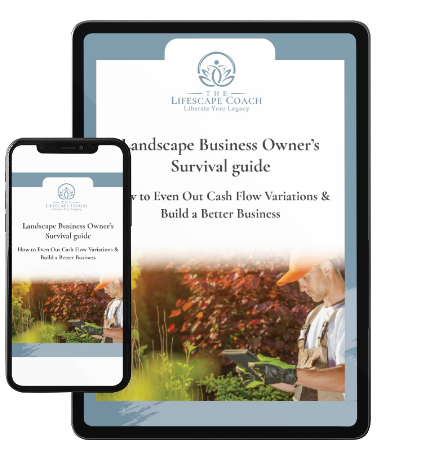To Make a Huge Impact On Your Profits, Understand These Elements of an Estimate
One of the most significant fail points in the landscaping industry is the inability to estimate project costs accurately. If your goal is to be more profitable as a landscape business, you must devote the proper amount of time to the estimation process. We all want to deliver speedy service to clients, but it’s just as essential to get adequately paid for the service you provide. Review these elements of a comprehensive estimate to build more accuracy–and profit–into your project estimates.
Be clear on the client’s needs, wants, and wishes
When it comes to understanding what the client wants, there is no room for ambiguity. If you aren’t 100% clear on the vision, ask more questions–and listen very, very carefully to the answers. Hypervigilance as a listener will help you to hear what the client is asking for but also to read between the lines of the words they’re speaking. Parrot back what you hear, and be curious about their answers. Asking more sophisticated questions will often get you the data you need to make the right decisions for them in the long run.
As you listen and determine the client’s vision, it’s important to remember that they are not the industry expert; you are. They may not (and likely won’t) know the right answer to the issue at hand. Or, the solution they think is right may not actually be feasible. You must be brave enough to say no to a client who is asking for the wrong thing. Set aside the idea that ”the customer is always right” and be willing to challenge their thinking while trying to honor and capture the essence of their request.

Estimating is not always linear
Don’t make the mistake of imagining estimation to be a straightforward process. To estimate correctly, you need to uncover information from all possible angles. It helps to think of estimation as a spiraling process, where your plan develops gradually and is tweaked every time you collect a new piece of data. The spiral tightens as you gather the information, until you have a fully formed plan in place for the project that can be clearly articulated to the client.
It’s entirely possible you will face pressure from other contractors or from the client to move faster. Resist this and stick to your process. In the end you’ll be saving everyone time and money, but most especially you save yourself stress and anxiety once is comes time to break ground.
Gather ALL the data on existing conditions
Before you can work with a piece of land, you must fully understand the existing conditions–even, and especially, the ones you cannot see. When building a landscape, 99 projects out of 100 will require you to dig into the ground. You may have to call Dig Safe, do some preliminary digging of your own, get a or obtain a soil test. At the very least, you will need to do a visual inspection of what you can see to hypothesize about what may be under the surface.
If you shortchange the data-collection process, you’re left to work based on assumptions that may prove faulty. For example, if you fail to take into account the trees already growing in a given area, you can grossly underestimate the amount of work needed to achieve your planting goals. An estimate based on the need for one or two employees digging will get blown out of the water once you discover an enormous tangled root structure that requires use of a machine.
In one instance, I spent a great deal of time designing a concept involving a wall and steps that my clients absolutely loved. A quick call to Dig Safe revealed that there was a gas line running under my proposed wall, making it impossible to build. That one quick call saved me time, money, and embarrassment in front of my client.
Accurate estimation requires a bit more of your time up front to look forensically at the landscape and ask yourself, What was here before? What may have happened on this land in the past that might set me up for a problem? How can I avoid unforeseen problems by looking a little deeper?

Know the rules and regulations
The most well thought-out landscape design will be useless if it fails to take into account the local zoning regulations applying to the property. Be sure to research whether the property is in a historic district or conservation jurisdiction. Know whether there are setback regulations, rights of way or easements in place that will affect your plans.
I once worked on a landscape project where a contractor hired by the client constructed a beautiful stone wall, only to discover that it was not allowed by the town’s regulations. The contractor assumed the cost not only of building this wall, but of having to tear it down. You can avoid situations like these by completing your research ahead of time.
“Mind the gap”
By this point, you should have a clear understanding of the client’s needs, wants, and wishes, and the facts on the ground. In between the two is a gap between what they have and what they want that is critical to measure. The size of this gap will correlate directly to the size of the estimate.
Many, many landscape professionals miscalculate how this gap corresponds to the estimate. In particular, the amount of pre-work that needs to be done is often underestimated. This includes planning, purchasing, delivery, mobilization, staging, scheduling, permitting, and possibly deconstruction. These costs are not minor, and yet they’re often overlooked because of a hyperfocus on the actual build itself. In my book, STOP Landscaping, START Life-Scaping, I devote two chapters demystifying the estimating process.
Don’t forget about the post-work
The build may be finished, but the job, and your costs, are certainly not. When you estimate a job, be sure to include all of the post-build work, including testing, cleanup, demobilization of your equipment, restocking, debris disposal, invoicing, and tracking materials.
This post-work continues even after you’ve left the job site in sparkling condition. The time spent cleaning your truck and trailer and getting your equipment back to project-ready should be included in your estimate. Do not do this work on your own nickel.
Lastly, your estimate should factor in project monitoring and client follow-up, particularly for jobs that involve planting where you may need to administer some follow-up care. Consider also whether you want non-maintenance clients to assume control and care of your project afterwards. If you are guaranteeing your work, determine an interval for on-site visits to assess the state of the project over the course of the next 30 days. This should also be factored into your costs.
And while you may not charge for it, set up a system where you are checking in with your client 15 or 30 days out to make sure they are happy with the work and have an opportunity to get their questions answered. This is the best way to build trust and establish a long-term relationship so the client will call you for the next job.
Summary
The worst thing that you can do for yourself and for your profits is to rush the estimating process. To be a truly proficient estimator, you must build the job in your mind and then on paper, from the very early stages of pre-work all the way through the last day of post-work. Do your due diligence, be methodical, maybe even get a second set of eyes on it when you have that resource, and watch your profits increase.
Did you find this article enlightening? Are you looking to elevate your landscape business to new heights? If you're curious about the potential benefits of coaching for your landscape business, we invite you to download the eBook "25 Signs Your Landscape Business Needs Developmental Coaching" to find out more. 
Landscape Business Owners Survival Guide


